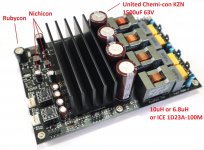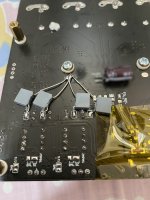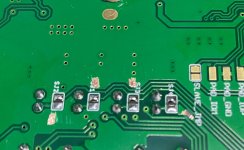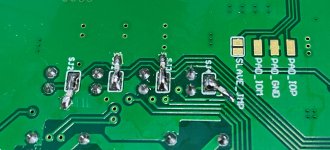For non-PFFB, there is no problem if there is no load connected.
For PFFB I would be cautious on running it without load. (Specially if there is a source connected, and has a music output)
.
Hi Leser,
TI PFFB application report mentions "open load" stability. Does your PFFB design tested for open load conditions?
If not, what would be a minimum resistor I can use as a pilot load (in case I want to swich ams during operation)?
Thanks,
Aviv.
D
Deleted member 148505
Hi Aviv,
Sylph-D200 PFFB is not yet tested in open loads, I'll test it in month's time. You need a minimum of 20ohms to tame the output filter LC resonance.
You can skip the dummy load resistor if you can mute the amp (header pins 3 and 4) or short the inputs before and during removal of speakers.
Regards,
Lester
Sylph-D200 PFFB is not yet tested in open loads, I'll test it in month's time. You need a minimum of 20ohms to tame the output filter LC resonance.
You can skip the dummy load resistor if you can mute the amp (header pins 3 and 4) or short the inputs before and during removal of speakers.
Regards,
Lester
Hi Leser,
TI PFFB application report mentions "open load" stability. Does your PFFB design tested for open load conditions?
If not, what would be a minimum resistor I can use as a pilot load (in case I want to swich ams during operation)?
Thanks,
Aviv.
D
Deleted member 148505
By minimum of 20 Ohm i assume you mean 20 Ohm or lower value right?
Yes correct, <= 20 ohms
D
Deleted member 148505
Interesting listening comparison between Purifi Eigentakt vs AHB2. The reviewer reported that the Eigentakt has a stronger midbass / low-midrange.
Benchmark AHB2 / Class D Purifi Eigentakt / Mark Levinson 333 - Listening impression & Conclusion | Audio Science Review (ASR) Forum
Reminds me my PFFB vs non-PFFB comparison of my module.
With my latest build, PFFB sound has a strong bass, and the highs are slightly finer. Using Motu M4 balanced source, there's no constrained sound at all (probably because there's a lot of bass) but the vocals are behind the soundstage. (so probably the lower-midrange is weaker)
Non-PFFB has stronger midbass/low midrange (120hz-300hz), and vocals are more forward sounding.
Benchmark AHB2 / Class D Purifi Eigentakt / Mark Levinson 333 - Listening impression & Conclusion | Audio Science Review (ASR) Forum
Reminds me my PFFB vs non-PFFB comparison of my module.
With my latest build, PFFB sound has a strong bass, and the highs are slightly finer. Using Motu M4 balanced source, there's no constrained sound at all (probably because there's a lot of bass) but the vocals are behind the soundstage. (so probably the lower-midrange is weaker)
Non-PFFB has stronger midbass/low midrange (120hz-300hz), and vocals are more forward sounding.
D
Deleted member 148505
I prefer non-PFFB because it is more natural sounding. Then there's TPA3251 which has a stronger midrange than TPA3255. But on TPA3251, there's a coloration on the sound on mid-highs that I can't describe. When I quickly change the amp to a TPA3255 module, the sound is definitely more neutral and cleaner. So with compromises weighed-in, I prefer the TPA3255 for its pure sound.
Hi Lester, thank's a lot for sharing this TPA3251/3255 comparision.I prefer non-PFFB because it is more natural sounding...on TPA3251, there's a coloration on the sound on mid-highs that I can't describe. When I quickly change the amp to a TPA3255 module, the sound is definitely more neutral and cleaner. So with compromises weighed-in, I prefer the TPA3255 for its pure sound.
Are the differences heard with as similar as possible PCB/components, assessing sounding differences of the chips (not their implementation) ?
I too prefer no PFFB (and open loop), for its "natural/free" rather than "processed/controled" sounding.
D
Deleted member 148505
Hi Lester, thank's a lot for sharing this TPA3251/3255 comparision.
Are the differences heard with as similar as possible PCB/components, assessing sounding differences of the chips (not their implementation) ?
I too prefer no PFFB (and open loop), for its "natural/free" rather than "processed/controled" sounding.
Yes I compared it using identical board and parts. TPA3251 has a more organic sound, same transparency and air but has less refinement compared to a module with TPA3255 IC.
In an ABX test, TPA3251 might win outright, but on longer listening sessions you will also like the TPA3255.
D
Deleted member 148505
Hi SinGun,
Attached corrections.
Sylph-D200 uses:
Elna Silmic II input coupling caps
United Chemi-con KZN series PVDD caps.
Nichicon / Rubycon on housekeeping supplies.
Sylph-D200 also has bulk capacitors on GVDD_AB and GVDD_CD supplies. I think I'm the first to implement it in any TPA325X modules.
Also added ICE 1D23A-100M as an option for output inductors.
Regards,
Lester
Attached corrections.
Sylph-D200 uses:
Elna Silmic II input coupling caps
United Chemi-con KZN series PVDD caps.
Nichicon / Rubycon on housekeeping supplies.
Sylph-D200 also has bulk capacitors on GVDD_AB and GVDD_CD supplies. I think I'm the first to implement it in any TPA325X modules.
Also added ICE 1D23A-100M as an option for output inductors.
Regards,
Lester
Attachments
Last edited by a moderator:
Yes I compared it using identical board and parts. TPA3251 has a more organic sound, same transparency and air but has less refinement compared to a module with TPA3255 IC.
In an ABX test, TPA3251 might win outright, but on longer listening sessions you will also like the TPA3255.
If someone wants more organic sound with the TPA3255, this is very easy to achieve: Use Silmic II caps as bypass or even change the original caps to Silmic II, you can dosage the amount of body/warmth yourself. If Silmic II is too powerful in the upper bass/lower mid region try instead the Nichicon VZ caps (they are also much cheaper).
D
Deleted member 148505
If someone wants more organic sound with the TPA3255, this is very easy to achieve: Use Silmic II caps as bypass or even change the original caps to Silmic II, you can dosage the amount of body/warmth yourself. If Silmic II is too powerful in the upper bass/lower mid region try instead the Nichicon VZ caps (they are also much cheaper).
Silmic II as bypass for PVDD power caps?
Additional warmth is easily recognizable when Silmic II is used as input coupling caps. Treble in 10kHz to 16kHz range is more pronounced on Silmic II, compared with others.
I'm using 4.7uF Wima MKS right now for input coupling caps, voice is not that great but it has a lot of bass.
D
Deleted member 148505
My best sounding Sylph-D200 here has the following configuration.
10uF Elna Silmic II
Panasonic FC 50V 1500uF PVDD bulk caps
6.8uH Coilcraft + 0.68uF output cap.
1.5X gain (default is 1.3X)
450kHz Sw freq (default)
non-pffb
43VDC supply
The voice is very good and life-like and highs are very smooth even if I use it with my cheap chinese meanwell clone supply.
The only drastic change between the modules is the choice of output inductor and output cap. So I think for existing users, since changing the output inductors is expensive, a cheap upgrade will be the output filter caps, since it can add improvements in the sound.
10uF Elna Silmic II
Panasonic FC 50V 1500uF PVDD bulk caps
6.8uH Coilcraft + 0.68uF output cap.
1.5X gain (default is 1.3X)
450kHz Sw freq (default)
non-pffb
43VDC supply
The voice is very good and life-like and highs are very smooth even if I use it with my cheap chinese meanwell clone supply.
The only drastic change between the modules is the choice of output inductor and output cap. So I think for existing users, since changing the output inductors is expensive, a cheap upgrade will be the output filter caps, since it can add improvements in the sound.
D
Deleted member 148505
Worthy SQ mod for PFFB users: place 100pF or 220pF C0G or polypropylene across PFFB jumper and ground.
Attached pics.
Attached pics.
Attachments
D
Deleted member 148505
Worthy SQ mod for PFFB users: place 100pF or 220pF C0G or polypropylene across PFFB jumper and ground.
Attached pics.
Erratum, should be around 10pf to 22pf only.
By what mechanism would this help the SQ, do you think?Erratum, should be around 10pf to 22pf only.
D
Deleted member 148505
By what mechanism would this help the SQ, do you think?
Just messing around with the feedback network 😉
I'm still comparing the sound with or without them so kindly ignore this mod yet..
Let me ask the question in a different way. Do you recommend this modification and what effects does it have on sound quality?By what mechanism would this help the SQ, do you think?
D
Deleted member 148505
Let me ask the question in a different way. Do you recommend this modification and what effects does it have on sound quality?
Yes, I recommend it only if you like PFFB. Use only around 1pF to 3pF, (not 10pF to 22pF as stated before). Too much and it will affect high frequency response.
For the SQ, vocals will be improved, but will make it slightly more forward sounding. PFFB has a crisp sound so the mod will also make the sound rounder. For ex. you can notice it on guitar plucking etc..
- Home
- Amplifiers
- Class D
- JLE TPA3255 Build and Modifications





